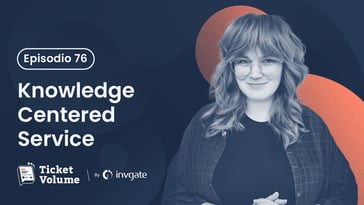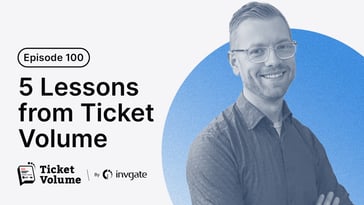As the complexity of the help desk staffing model continues to grow, businesses grapple with essential questions – When is the right time to expand the team? How to identify and hire the best-fit candidates? And what's the ideal headcount for an efficient service desk?
In our October Ticket Volume podcast live recording, we took a deep dive into these questions and analyzed “Staffing For Service: Models, Volumes, And Training”. For the very first time, we brought together a panel of esteemed experts including Jacob White, Kincy Clark, Simone Jo Moore, and Daniel Breston. Along with Ticket Volume host and InvGate Product Specialist, Matt Beran, they delved into service staffing, available models, and training to build the best IT support team.
Read on for a quick recap of this episode – and don't forget to sign up for our monthly webinars to deepen your understanding of these crucial topics.

What is a help desk staffing model?
Kinsey Clark describes a staffing model as a vital tool used to plan and forecast staffing needs. Its complexity can vary widely, depending on the organization's maturity, industry, and ability to predict future needs. He distinguishes between long and short-term models:
- Long-term staffing models - They focus on projecting an organization's growth and development over time.
- Short-term staffing models - They are tactical and handle daily operations.
Simone Jo Moore adds a valuable perspective, noting that staffing models are both an art and a science, combining mathematical and statistical components with creative and human factors.
Strategies to deal with turnover
Dealing with turnover in any organization is a complex and evolving challenge that requires a multifaceted approach. The panelists provide insights and strategies for addressing it, considering the dynamic nature of the modern workforce and the skills and capabilities required.
1. A proactive approach
Jacob White emphasizes the importance of prevention. High turnover can be detrimental to an organization, both in terms of productivity and morale. To address this, organizations should:
- Provide existing teams with the support and resources they need to succeed.
- Set clear expectations for both the team and upper management.
- Communicate effectively with customers and stakeholders during periods of staffing challenges.
- Streamline the onboarding process for new hires to get them up to speed quickly.
- Continually assess processes and tools to alleviate pressure caused by understaffing.
2. A forward-looking approach
Daniel Breston introduces a forward-looking perspective on turnover, acknowledging the evolving nature of employment dynamics. In the post-COVID world, organizations must adapt by:
- Skills-centric focus - Shift from a purely numbers-driven model to a skill and capabilities-centric approach.
- Fluid turnover - Recognize that turnover is fluid and can occur rapidly due to shifts in the business landscape.
- Adaptive organization - Be flexible and prepared to reshape the organization based on skills and capabilities rather than traditional roles.
3. Balancing automation and human capabilities
Simone Jo Moore highlights the dynamic nature of turnover and the need to balance automation, customer demands, and human capabilities. Consider:
- Sustainability through fluidity - Acknowledge that turnover is an ever-changing challenge and plan for it proactively.
- Skills alignment - Adapt to the skills and capabilities required by the business rather than static roles.
- Reskilling and transition - Focus on helping employees transition out of roles as much as onboarding new hires.
|
|
"Let's face it, you can't provide a $6 million service on $6. That just doesn't happen that way. So I think they have to wake up to the reality of what the necessities are and also wonder at the amazing capability that actually lies within their people if you want it to be sustainable." Simone Jo Moore |
4. Turning turnover into an opportunity
Kinsey Clark discusses how turnover can be seen as an opportunity to cycle talent through the organization. Consider:
- Talent generation - Embrace turnover as a way to generate new talent, especially for entry-level positions.
- Preventative measures - Develop plans and strategies for preventing turnover and ensuring preparedness for when it does occur.
Balancing understaffing and overstaffing
The conversation next turns to the challenge of understaffing and overstaffing in the context of help desk staffing models. As the conversation unfolds, each panelist provides a unique perspective and practical recommendations:
1. Redefining understaffing and overstaffing
Daniel Breston encourages a fresh perspective by suggesting a shift towards "right-sizing" staff according to specific business needs. He advocates for viewing this as an ongoing journey, acknowledging the service desk's pivotal role in shaping the organization's trajectory.
|
|
"The only place in IT that has the truth is the service desk. They know all the good stuff and all the bad stuff; all the good people and all the bad people; all the good vendors and all the bad vendors because that's all they do all day long. So (...) if you let your service desk fluctuate as part of a team of individuals that is managing and creating a service or a product, then your service authority is going to grow daily." Daniel Breston |
2. Preventing understaffing through business alignment
Kincy Clark takes a pragmatic approach, emphasizing the role of a leader in ensuring alignment with business priorities. He recommends making a compelling case for staffing that revolves around measurable business outcomes, connecting the team's role directly to customer satisfaction and business drivers.
3. Adapting to workforce dynamics
Simone Jo Moore highlights the dynamic nature of staffing in today's landscape, driven by the increasing complexity of tasks due to automation. She discusses shifts in metrics, such as Average Handle Time (AHT), underscoring the need to recruit individuals capable of handling complex, cognitive tasks demanding problem-solving skills and a broader skill set.
4. Skill gap and development
Jacob White underscores the necessity of continuous vigilance concerning skill gaps within the team. He stresses the significance of aiding individuals in developing the skills required to tackle more complex tasks, contributing to the organization's overall success.
Succession planning in help desk staffing models
The panelists transition to discussing succession planning as a solution for addressing skill gaps and maintaining a well-balanced workforce. Succession planning involves identifying skill needs and developing talent within the organization to fill these needs in the future. It offers a proactive approach to ensuring the workforce remains adaptable and well-equipped to handle evolving challenges and opportunities. This synergy with succession planning aligns with the following key principles:
- Nurturing talent and cross-departmental growth - Jacob White emphasizes the value of cultivating talent within the service team and then channeling this talent into other areas of the organization. This practice, aligned with succession planning, entails mentoring, skill enhancement, and preparing individuals for career progression.
- Proactive skill development for short-term roles - Jacob stresses the importance of acknowledging shorter tenures in service roles and taking a proactive approach to train and develop these employees. Investing in their skills, even if they may leave relatively quickly, is preferable to retaining undertrained and unskilled staff.
- Continuous learning and embracing change - Panelists stress the significance of fostering continuous learning and adaptability. Succession planning involves helping employees acquire skills for their future roles, whether within the same organization or beyond. Simone Jo Moore encourages embracing redundancy as an opportunity for personal and professional growth.
- Skills frameworks and self-assessment - Daniel Breston recommends utilizing skills frameworks and self-assessment to align one's skills with the organization's direction. These frameworks aid in identifying the skills needed for future roles, whether it involves succession planning, career advancement within the same organization, or exploring opportunities elsewhere.
Coverage strategies
Regarding service desk operations, coverage strategies are like multifaceted gems whose complexities and importance are not always immediately apparent. Recognizing the challenges of this aspect, the panelists highlight some key strategies and their role in ensuring comprehensive coverage.
- Embrace diversity in all forms - When crafting coverage strategies, it's crucial to acknowledge and embrace diversity in its many dimensions. This includes geographical, cultural, and skill-based models. One size does not fit all, and what works for one organization might not suit another.
- Geographical considerations - Recognize the importance of managing time zones effectively. In a globalized world, it's essential to provide consistent support, regardless of the hour. Tailor your coverage to meet the expectations of customers worldwide.
- Cultural sensitivity - Cultural diversity is a vital aspect, both for international and local teams. Different cultures may observe varying holiday schedules, religious observances, or other customs that need to be accommodated within your coverage plan.
- Legal and safety requirements - Consider any legal or occupational health and safety requirements related to coverage. This may include having a minimum number of agents on shift to handle potential emergencies, regardless of call patterns.
- Team involvement - Involve your team in shaping the coverage model. They are the ones who will live it every day. Encourage their feedback and input to find a solution that works for everyone. Shared responsibility and empowerment can lead to innovative solutions that benefit both employees and the organization.
|
|
"I think the key is to look at your organization and see what makes sense, there is no coverage model to rule them all. It's going to be very dependent on the business and what type of service you're trying to deliver. Do you have a 24/7 requirement? (...) How do you stretch languages across time zones and things like that? (...) Build a few different models to look at that and then hit that around with your team." Kincy Clark |
Rebuilding support in-house: Where to begin?
Rebuilding support functions in-house or establishing a new service desk from scratch can be a challenging task. To navigate this process effectively, the panelists outline several critical factors to consider:
Start with people
Regardless of your specific circumstances, people should be your first priority. Begin by hiring a core team of dedicated individuals. While hiring one person to cover 24/7 service isn't feasible, the initial team should possess diverse skill sets, including strong documentation abilities and flexibility to manage different processes and technologies. They will help shape your future decisions.
|
|
"Specially starting from scratch, you do need humans to help you figure it out. So you're not a one-person band trying to staff 24/7, that's just not feasible. You need to ask the questions of what's most important, you need to hit SLA and all that other fun stuff that's required, and then start. Lean with your staffing, one or two people, and then make your business, your growth decisions as you move forward." Jacob White |
Context matters
Every situation is unique. Consider the complexity of your work, the need for 24/7 support, and the nature of your organization's service requirements. These factors will dictate your approach. There's no one-size-fits-all solution.
Documentation and processes
Document your support processes thoroughly. These documents will not only help in training but also in evaluating tools that can automate and streamline these processes. Tools should come after you understand what processes are essential.
Engage with HR
Collaborate with your HR department to ensure you align your hiring strategies with your service desk's growth needs. Educate them about the specific skills and attributes you require, and work together to establish a robust recruitment and training process.
To conclude
This is just a glimpse into the in-depth conversation with Jacob White, Kincy Clark, Simone Jo Moore, and Daniel Breston on Ticket Volume. The full episode is a rich source of valuable insights and ideas! You can listen to it on platforms like Apple Podcasts, Spotify, YouTube, or your favorite podcast platform. And if you’re eager to learn, remember to subscribe to our live monthly webinars!















